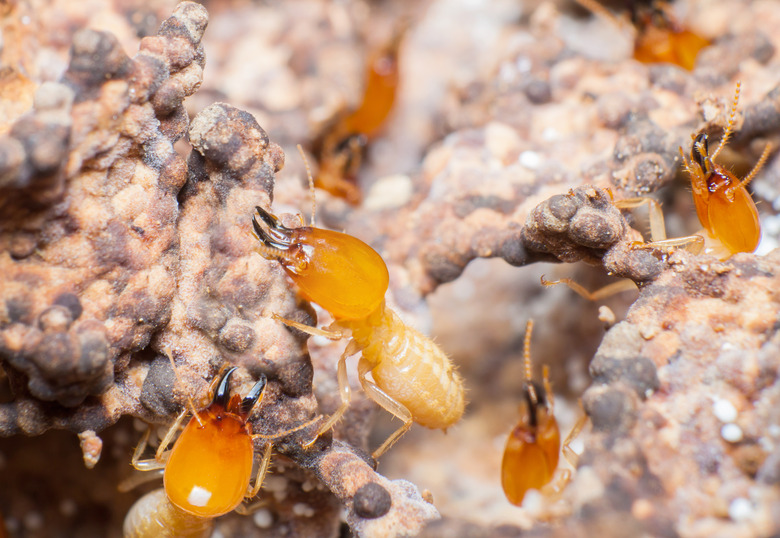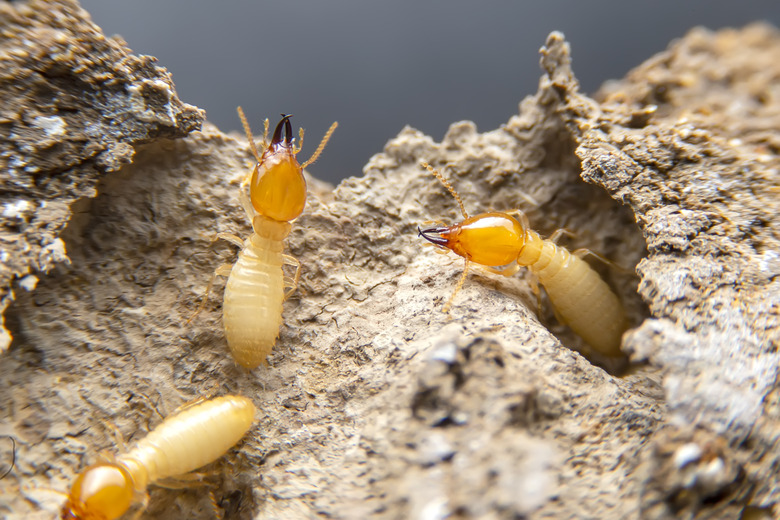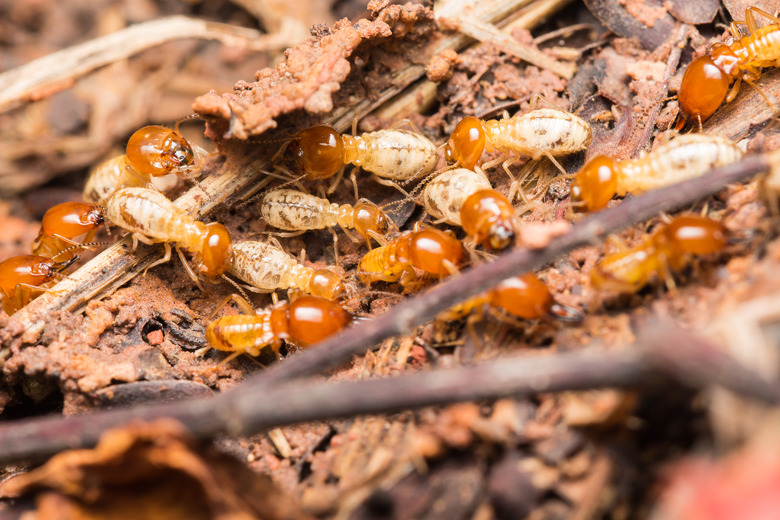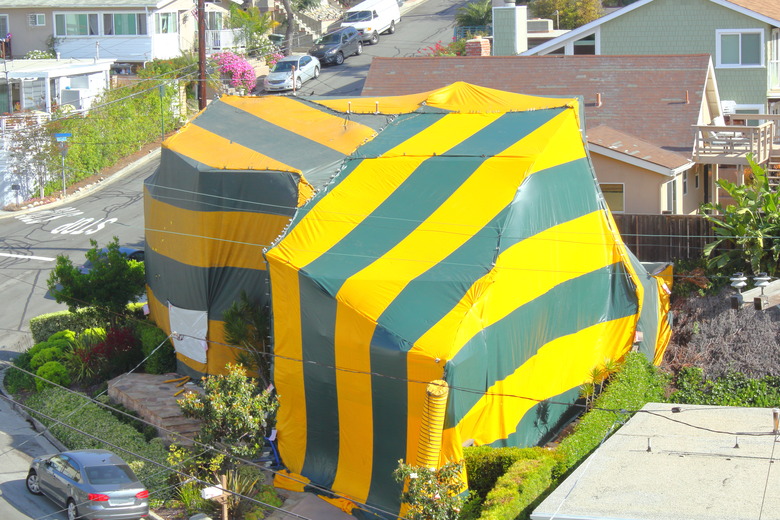How To Get Rid Of Termites
We may receive a commission on purchases made from links.
The first indication of a termite infestation is the spring appearance of winged insects flying through the house, and while they look like winged ants, it's fairly easy to identify them. The winged termites are called swarmers, and they represent the tip of the iceberg. When you see them, you can be sure a full-fledged colony is nearby. Colonies don't produce swarmers until they have been established for some time — about four years — and the swarmers don't fly very far. The rest of the colony consists of workers and soldiers, and they usually stay out of sight in the walls or foundation where they are busily munching on the house.
Unlike carpenter ants, which burrow in wood but don't eat it, termites live on cellulose. It's no secret that termite damage to wooden structures often necessitates expensive repairs, so when a home changes hands, a termite inspection is usually conducted as part of the home inspection. The tunnels termites burrow through wood seriously undermine it and can cause sinking floors, sagging and leaking roofs, and other major structural problems. There are several termiticide products on the market for DIY termite control, although not all are available in every state. Controlling a serious infestation is a job for professional exterminators, who may resort to tenting and fumigating the entire house to kill the colony.
What Do Termites Look Like?
What Do Termites Look Like?
- Species name: Isoptera spp.
- Physical characteristics: 1/8 to 1 inch in length; coloration can be white, brown, or black
depending on species; worker termites have soft, larvallike bodies;
soldier termites have large heads and mandibles. - Wings or wingless? At
a certain stage in the life cycle of a termite colony, winged termites
known as alates appear. Sometimes known as swarmers, their purpose is to
establish new colonies.
- Color/species varieties: There are 2,000 types of termites worldwide, but five are especially problematic for North American homeowners. They are subterranean termites, which are white or beige; drywood termites, which have light orange bodies and dark orange heads; dampwood termites, which are uniformly orange with light orange stripes on the back; Formosan termites, which have milky white bodies and heads; and conehead termites, the soldiers of which have distinctive cone-shaped heads.
- Life cycle and appearance: Termite
colonies have a caste system consisting of workers, soldiers, and
swarmers. The latter emerge in the spring, and their yearly appearance
leads to a misconception that termites are only active in spring, which
isn't true. The colony is active all year. - How to tell apart from lookalikes: Winged
termites are often mistaken for flying ants, but there are notable
differences. Termites have straight waists, while those of ants are
pinched, essentially dividing the head and lower abdomen into two
distinct sections. Termites have straight antennae and wings of equal
length, while ants have bent antennae and wings of unequal length.
How to Get Rid of a Termite Infestation
How to Get Rid of a Termite Infestation
The most effective termite treatment depends on the type of termites you're trying to control. Some termites, including drywood, dampwood, Formosan, and conehead termites, nest in wooden structures in the building, whereas subterranean termites spend most of their time at ground level and in mud tubes they build to preserve moisture. When you see termites scurrying on the ground around the foundation or in the crawl space, they are usually the subterranean variety, whereas termites that can be seen emerging from window casings are usually living in the structure.
Use a Termiticide or Baiting
Some of the termite treatment chemicals available to homeowners include termiticides, such as Taurus SC and BioAdvanced Termite Killer, which kill termites that contact it and can also spread like a virus throughout the colony. The usual way to use these products and others like them is to spray them around the home's foundation to create a barrier that the insects can't cross without contacting the chemical.
Inside the home, you can use a product like Termidor foam, which expands to fill cavities and crevices in walls where termites hide and then dissolves, leaving behind a film that kills the insects on contact. You can also spray this on any insects you see, and it will kill them on contact.
Baiting is a proven method for combating subterranean termites. Termite bait stations typically come in the form of stakes that you drive in the ground 2 to 3 feet away from the foundation and no more than 10 feet apart. The stations contain a slow-acting insecticide that allows the insects to bring it back to the nest and kill the entire colony. Spectracide bait stations feature pop-up indicators that alert you to termite activity and let you know that the insects are going for the bait.
Drill Holes for Applying Insecticide
Drywood termites can enter the house from anywhere, not just the ground, often finding a path to the roof on overhanging tree branches and entering through the soffit or fascia to live in the attic. These are the insects primarily responsible for frass (termite droppings, which look like tiny wood pellets), so wherever you see it, the ceiling or wall just above the deposits is the best place to spray insecticide or use organic control methods. You may need to drill small holes spaced about 10 inches apart into the wood to provide openings for the insecticide.
When to Hire a Pro
When to Hire a Pro
A persistent termite problem is always a job for a professional pest control company, especially when tenting and fumigating is required, as it usually is in humid climates where termites thrive. DIY measures can be effective for small colonies, but because the presence of one colony usually indicates the presence of others in places where the insects haven't yet been spotted, it's prudent and even necessary to schedule a professional termite inspection and to follow the inspector's recommendations.
Getting Rid of Termites Naturally
Getting Rid of Termites Naturally
A termite infestation is not a good candidate for an integrated pest management approach, which seeks to minimize the use of pesticides. You pretty much have to kill termites to get rid of them. Once they are established in your home or garden, you aren't going to be able to coax them to leave with a deterrent or repellant, although you may be able to prevent them from establishing new nests. You don't necessarily have to use a termiticide, though, because a number of safe home and garden chemicals can be effective:
- Boric acid: The active ingredient in many ant and termite baits, boric acid interferes with the insects' digestive systems and poisons them, but it's also an effective treatment when used externally as a dusting agent. Spread it along foundation walls, inside crevices where there is termite activity, in crawl spaces, and on outdoor mounds and tree stumps on which you've seen signs of termites. It clings to the insects' bodies, and they die by ingestion when they groom themselves.
- Diatomaceous earth: Composed of microscopic seashells, DE lacerates the bodies of insects that walk over it. Spread this around the home's foundation and in crawl spaces to keep away termites. It can also be used in the garden where termite activity is apparent.
- Beneficial nematodes: Natural insect predators, beneficial nematodes are microscopic roundworms that burrow into a termite's body and infect the insects with bacteria. These are especially useful in the garden, where you can mix them with potting soil and spread the soil in areas that have a termite problem.
- Orange oil: Commonly used by professional exterminators, orange oil is safe to use in the house and kills on contact. You can purchase full-strength orange oil and dilute it with 10 parts water, or you can purchase a premixed orange oil insecticide, such as Orange Guard.
How Quickly Can You Get Rid of Termites?
How Quickly Can You Get Rid of Termites?
You may be able to kill termites you see on contact, but getting rid of an entire colony by yourself is bound to take some time, and you may not be able to do it yourself. Some methods are faster than others. For example, baiting may be effective, but it can take several weeks for the insects to spread the bait among the colony. If you hire a professional service to fumigate your house and your house is covered with a tent, the tent may have to stay there for several days to a week, but some other professional methods are faster, taking only one day. Complete eradication of a large, well-established colony may call for several professional treatments spread over a year or more.
How Termites Get In Your House
How Termites Get In Your House
Subterranean termites can enter a building on foot by building mud tunnels over obstructions, such as foundation footings. Unlike other insects, like ants and cockroaches, that are looking for food crumbs, termites are attracted to homes with available cellulose and moisture, and they are most likely to find that in damp wooden foundation members, such as floor joists, wall plates, and foundation beams.
The most common way for termites to get inside is for winged swarmers, which are capable of reproducing and emerge in spring, to enter through any opening through which they fit. They are typically looking for nesting places in which they can start new colonies and feed their young on wall studs, rafters, and wood flooring. All it takes is one winged male and female to start a colony. Swarmers can't fly far by themselves, but they are often carried far afield by the wind.
The males and females shed their wings when they mate, and the female — now the queen — lays eggs in batches of 12. Each queen is capable of hatching thousands of eggs each year. At maturity, a typical termite colony consists of 60,000 to 1 million termites.
How to Prevent Termites
How to Prevent Termites
Once a termite colony is established, homeowners may be able to stop it from growing using chemicals, but they probably can't eradicate it completely. That's a job for a pest control company. To prevent things from getting to the point where a professional pest control service is needed, homeowners can take several preventative measures:
- Keep the area around the foundation free of moisture by repairing plumbing leaks and diverting runoff from the roof and air conditioner drain lines away from the house.
- Maintain an 18-inch spacing between the soil and any wooden parts of the house.
- Keep the foundation, fascia, window and door casings, skirting boards, and weatherstripping in good repair and check regularly for signs of activity, which could include mud tubes, stray insects, and weakened wood. You can check areas of suspected activity by poking a screwdriver into the wood; if it goes in freely with little resistance, there is probably deterioration from termites.
- Move woodpiles at least 20 feet away from the house and keep the area around the foundation clean.
- Strategically use your garden to deter termites by planting things like mint or veviter grass, which termites dislike.
- Schedule a yearly termite inspection with a local pest control company.
Do Termites Cause Damage/Spread Disease?
Do Termites Cause Damage/Spread Disease?
While termites cause extensive damage to wooden structures, they aren't known to carry disease, and while they may bite when disturbed, they have no venom, and the bite usually isn't very painful. Some people may suffer allergic reactions in homes infested by termites, but it's usually due to wood dust, frass, other byproducts of termite activity, or chemicals used in termite treatment.
If you have a termite infestation in the garden, it's usually because the colony has found a good source of cellulose — often an old tree stump or tree root. Termites sometimes attack plants, so it makes sense to get rid of them, but you'll have a hard time rooting out the colony by yourself. You can try to control it by digging it up or spreading mulch laced with orange oil, DE, or boric acid, especially around old dead trees, which are favorite feeding places. If you want to eliminate the colony once and for all, though, you'll probably need professional help.



